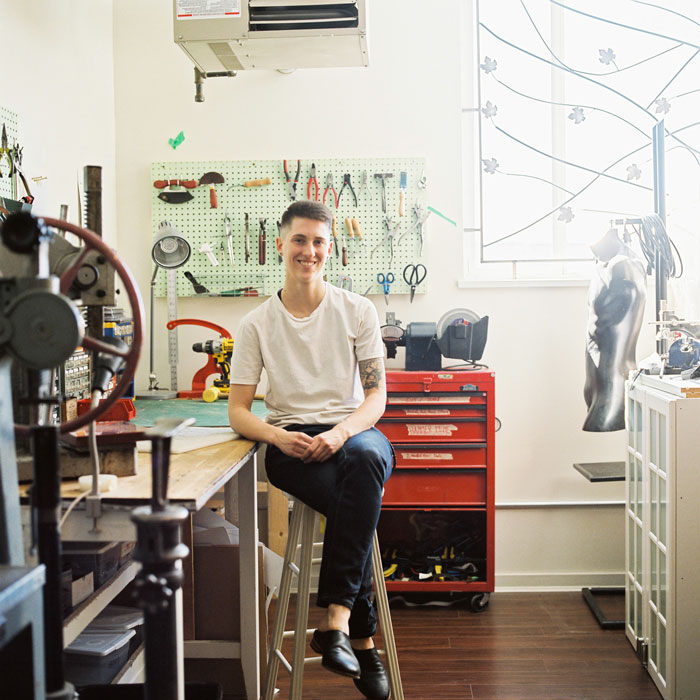Envisioning the Future of Shoe Repair
As a cobbler, I see how a new approach could help my old trade contribute to a circular economy.
When I open the doors to my East Vancouver cobbling shop, Awl Together Leather, I never know what will come through them—we’ve patched a leather tea cozy from the ’40s, remade a white leather driving coat for a local billionaire, saved a bison hide from mildew after the Fraser Valley’s disastrous 2021 flooding, and re-heeled many a wedding shoe. My seven years in this industry have never been boring, but it has shown me how behind we are in addressing rising concerns: diversity and equity within our ranks, fast fashion’s lack of sustainability, and how to pass on skills to future generations.
Shoe repair was once a cornerstone trade that communities of all sizes could count on to repair various essential items and provide stable careers. That is no longer the case. Shoe-repair shops across the continent are shuttering as their retiring owners cannot find anyone to take up the mantle. The solution is seemingly simple: we need a newly trained generation of cobblers who are keen to curb extreme textile waste through repair. Getting there is the tricky part.
Learning the trade can be difficult, mainly because of the two main styles of cobbling shops: the father-to-son enterprise or the one-man “mall cobbler.” From what I’ve seen, a lot of one-man shops are bought and sold cheaply, without the time for new owners to be mentored by their predecessors or build technical skills. This lack of mentorship often leads to bad reviews, burn-out, and closure. I’ve noticed that multi-generational shops typically have white owners and are also more well regarded, as they’ve inherited complex skills and better equipment. However, they typically exclude women, queer, Indigenous, or working-class labourers from gaining ownership status, and sometimes they gatekeep the trickier skills, such as how to operate the notoriously finicky outsole stitching machine.
For new cobblers, these challenges can be compounded by racism, sexism, and stubborn bosses. There’s a reason I’ve been using phrases like “father-to-son” and “one-man shop”: Currently 82% of people working in shoe-repair are men (and the same percentage are over 45). Cobblers are typically creative tradesmen that become self-employed to run their own show and don’t necessarily put in the time to become equitable employers or managers interested in growth and skill transfer. Unfortunately, stories of customers and bosses yelling at staff are not uncommon, nor is wage theft; see the half a million dollars’ of wages that Dayton Boots’ was found to have stolen in 2020.

Ariss Grutter sits at a workbench in the Awl Together Leather workshop.
Customers also don’t tend to realize that the median wage of Canadian cobblers is just $16.71 an hour, lower than BC’s $16.75 minimum wage. Comments like “I’m relieved that you speak English” or “Where are your men?” can dissuade diverse apprentices from continuing in the trade. As if the majority of the world’s clothing and shoes manufacturing isn’t done overseas by skillful and fast-sewing women of color.
Conversely, there is a growing demand for repair, with the established shops quoting month-long wait times while streamlining their services to focus on projects that turn the most profit. This destines items like handbags and sporting equipment for a landfill. There is also a growing number of people wanting to join the trade: every month our shop receives multiple applications from people eager to learn, who we don’t have the capacity to train. Training heirs for shoe repair shops will benefit us all, and the responsibility to do so should be shared across all types of shops.
The growing demand for repair doesn’t change the fact that the environmental impact of fast fashion in footwear and leather can’t solely be solved by repairers and consumers. Large companies often try to greenwash outlandish production volumes by launching small repair programs. Meanwhile the majority of their stock ends up in landfills. Materials that are designed with planned obsolescence—vinyls, TPU, and paper filled-soles—are becoming more popular and problematic. Consumers and repairers can do our best at reducing our own waste, but eliminating fast-footwear waste will require a fundamental shift in values and production.
Training heirs for shoe repair shops will benefit us all, and the responsibility to do so should be shared across all types of shops.
Cobblers are typically the front line in educating customers on sustainable footwear. And you can help us evolve—by supporting your local cobbling shop, paying or tipping towards livable wages, and investing in better-made footwear that is designed to be repaired. Daily, we hear from customers who are looking for alternatives to “one-season” shoes, sick of adding to landfill waste. For rural communities who have already lost their cobbler, we see an eagerness for mail-in services.
Cobblers have long been the original up-cyclers, diverting textile waste from landfills through repair, restoration, or remaking beloved items. While the retirement of a generation puts our industry at a tipping point, we are primed to help build a circular textile economy. The answer to the dwindling cobbler population lies in making our industry attractive to a new generation, diversifying who we imagine cobblers to be, and remembering all that we can repair.
Print Issue: Spring/Summer 2024
Print Title: A New Future for an Old Trade
